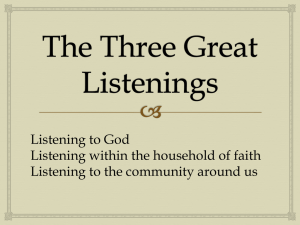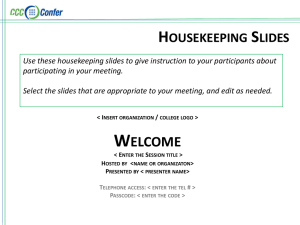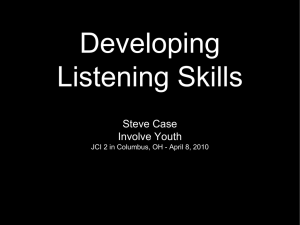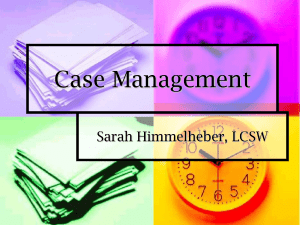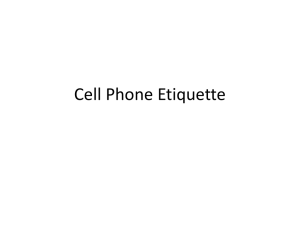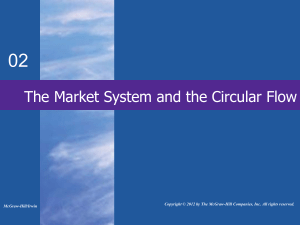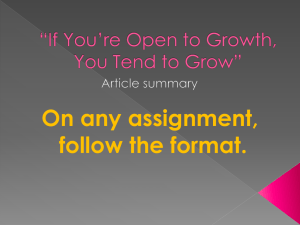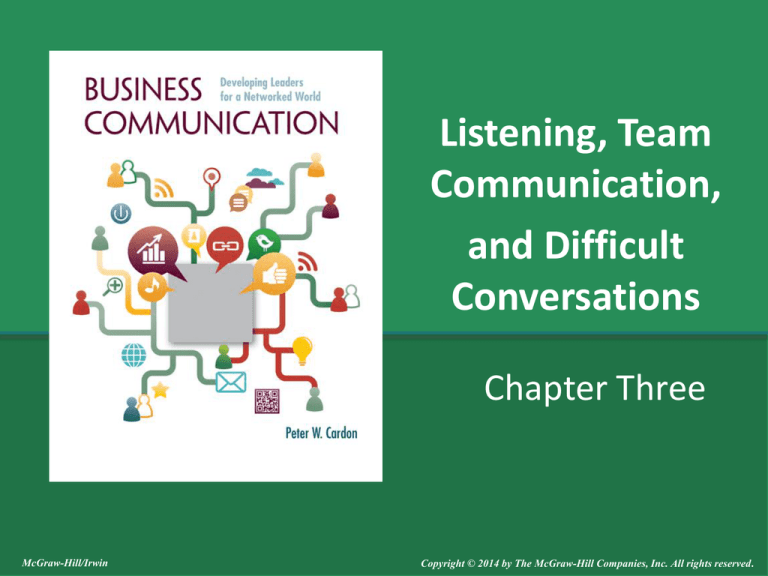
Listening, Team
Communication,
and Difficult
Conversations
Chapter Three
McGraw-Hill/Irwin
Copyright © 2014 by The McGraw-Hill Companies, Inc. All rights reserved.
Learning Objectives
LO3.1 Describe and evaluate the process of
active listening.
LO3.2 Explain and evaluate barriers to effective
listening an common types of nonlistening behaviors.
LO3.3 Describe the elements of questions that
enhance listening and learning.
3-2
Learning Objectives (cont.)
LO3.4 Explain the principles of team
communication in high-performing
teams.
LO3.5 Describe and demonstrate approaches to
planning, running, and following up on
meetings.
LO3.6 Explain basic principles for handling
difficult conversations.
3-3
Most Important Communication Skills
According to Business Graduates (2000–2010)
Table 3.1
3-4
Engaging in Active Listening
Active listening
“a person’s
willingness and ability
to hear and
understand.”
3-5
Six Skills in Active Listening
Paying
attention,
Holding
judgment
Reflecting
Clarifying
Summarizing
Sharing
3-6
The Traditional Chinese
Character for Listen
Figure 3.1
3-7
Paying Attention
This step involves devoting your whole
attention to others and allowing them
enough comfort and time to express
themselves completely.
As others speak to you, try to understand
everything they say from their perspective
Requires active nonverbal communication
3-8
Holding Judgment
People will only share their ideas and feelings
with you if they feel safe
Holding judgment is particularly important in
tense and emotionally charged situations.
Learner mind-set vs. judger mind-set
3-9
Holding Judgment
Learner mind-set
you show eagerness to hear others’ ideas and
perspectives and listen with an open mind
You do not have your mind made up before
listening fully.
3-10
Holding Judgment
Judger mind-set
people have their minds made up before listening
carefully to others’ ideas, perspective, and
experiences.
Judgers view disagreement rigidly, with little
possibility of finding common ground
3-11
Holding Judgment
Learner statements,
show your
commitment to
hearing people out
Judger statements,
show you are closed
off to hearing people
out, shut down
honest conversations
3-12
Judger Statements vs.
Learner Statements
Table 3.2
3-13
Reflecting
To make sure you
really understand
others, you should
frequently
paraphrase what
you’re hearing.
3-14
Reflecting Statements
3-15
Clarifying
Clarifying involves making sure you have a
clear understanding of what others mean.
It includes double-checking that you
understand the perspectives of others and
asking them to elaborate and qualify their
thoughts
3-16
Clarifying Statements
Table 3.4
3-17
Summarizing and Sharing
The goal of summarizing is to restate major
themes so that you can make sense of the big
issues from the perspective of the other
person
Active listening also involves expressing your
own perspectives and feelings.
3-18
Summarizing Statements
Table 3.5
3-19
Recognizing Barriers to
Effective Listening
Lack of time
Lack of patience
and attention
span
Image of
leadership
Communication
technology
Fear of bad
news
Defending
“Me too”
statements
Advice-giving
Judging
3-20
Defensive and Non-defensive
Replies
Figure 3.2
3-21
Asking the Right Questions
A crucial skill is the ability to ask the right
questions
Good questions reflect the learner mind-set,
and poor questions reflect a judger mind-set
Table 3.6
3-22
Types of Effective Questions
Table 3.7
3-23
Types of Counterproductive
Questions
Table 3.8
3-24
Common Functions of Teams
Handling special projects
Completing the work of particular departments
Developing internal systems innovations
Creating customer-service innovations
Developing product innovations
Engaging in employee development
Reducing time to market for products and services
3-25
Barriers to Team Effectiveness
Ineffective communication
Lack of effective chartering and goal setting
Lack of clarity and goal setting
Low morale
Low productivity
Lack of trust
3-26
Stages of Development in
High-Performance Teams
Figure 3.3
3-27
Stages of Development in
High-Performance Teams
Forming stage
team members focus
on gaining
acceptance and
avoiding conflict
Storming stage
team members open
up with their
competing ideas
about how the team
should approach
work
3-28
Stages of Development in
High-Performance Teams
Norming stage
the team arrives at a
work plan, including
the roles, goals, and
accountabilities
Performing stage
teams operate
efficiently toward
accomplishing their
goals
3-29
Principles of Effective Team
Communication
Effective teams
build a work culture around values, norms, and
goals
spend a lot of time discussing values, norms, and
goals
spend most of their time discussing work issues
meet often
embrace differing viewpoints and conflict
feel a common sense of purpose
3-30
Embracing Differing Viewpoints
Disassociation
process by which
professionals accept
critique of their ideas
without taking it
personally and
becoming defensive
Association
psychological
bonding that occurs
between people and
their ideas
3-31
Planning for Meetings:
Essential Questions
What is the purpose of the meeting? What
outcomes do I expect?
Who should attend?
When should the meeting be scheduled?
What roles and responsibilities should people
at the meeting have?
3-32
Planning for Meetings:
Essential Questions
What will be the agenda?
What materials should I distribute prior to
the meeting?
When and how should I invite others?
What logistical issues do I need to take care
of (reserving rooms, getting equipment,
printing materials)?
3-33
Creating and Distributing
the Agenda
Agendas provide structure for meetings
Most agendas should include:
items to be covered
time frames
goals and/or expected outcomes
Roles
materials needed.
3-34
Running Effective Meetings
Create Tradition, Culture, and Variety
Set Expectations and Follow the Agenda
Encourage Participation and Expression of Ideas
Build Consensus and a Plan of Action
Closing the Meeting
Dealing with Difficult People
3-35
Closing the Meeting
How much information, analysis, and
interpretation did I provide?
Did I communicate my ideas even if they
conflicted with someone else’s?
Did I participate in the implementation of the
timeline? Did I meet deadlines?
Did I facilitate the decision-making process? Or
did I just go with the flow?
3-36
Following Up After Meetings
Follow up by
distributing the
minutes of the
meeting
Memo, email, team
blog
3-37
Managing Difficult Conversations
Difficult conversations often center on
disagreements, conflict, and bad news
Many people prefer to avoid difficult
conversations because they want to avoid
hurting the feelings of others or want to
avoid conflict
3-38
Principles of Difficult
Conversations
Embrace difficult conversations.
Assume the best in others.
Adopt a learning stance.
Stay calm/overcome noise.
Find common ground.
Disagree diplomatically.
Avoid exaggeration and either/or approaches.
3-39
Components of Difficult
Conversations
1. Start well/declare your intent
2. Listen to their story
3. Tell your story
4. Create a shared story
3-40


